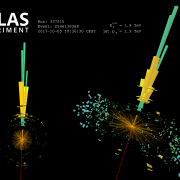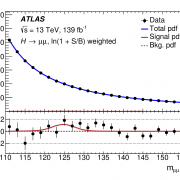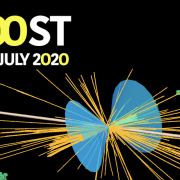Access to Collaboration Site and Physics Results
When a particle is transformed into its antiparticle and its spatial coordinates inverted, the laws of physics are required to stay the same – or so we thought. This symmetry – known as “CP symmetry” (Charge conjugation and Parity symmetry) – was considered to be exact until 1964, when a study of the kaon particle system led to the discovery of “CP violation”.
CP violation is an essential feature of our Universe. The imbalance between matter and antimatter, which led to the present-day Universe, is a consequence of CP-violating processes that occurred just moments after the Big Bang. However, the size of CP violation observed so far exclusively in the weak interaction is insufficient — by far — to account for the present matter–antimatter imbalance. New sources of CP violation must therefore exist.
The discovery of the Higgs boson has opened up opportunities for physicists to search for these new sources of CP violation. In a new result presented today, the ATLAS Collaboration performed a direct test of the CP properties of the interaction between the Higgs boson and top quarks. The result is based on an analysis of the full LHC Run-2 dataset, looking at collision events where the Higgs boson is produced in association with one or two top quarks, and decays into two photons. A similar analysis has been recently released by the CMS Collaboration.

Staying on top of the Higgs
As the top quark is the heaviest elementary particle in the Standard Model, it has the strongest interaction with the Higgs boson. This interaction has observable effects in the proton collisions at the LHC, producing a Higgs boson in association with a pair of top quarks (ttH) or with a single top quark (tH).
The ttH process accounts for approximately 1% of the Higgs bosons produced at the LHC, and was observed by the ATLAS and CMS experiments in 2018. However, the tH process is much rarer, in part due to destructive interference between contributions induced by the top–Higgs interaction with those induced by W-boson–Higgs interaction. This interference could be significantly altered when new physics processes are present, which could lead to an increase of the tH production rate.
In the Standard Model, the top–Higgs interaction conserves CP symmetry, a characteristic often referred to as “CP-even”. However, a CP-violating (or “CP-odd”) component of the top–Higgs interaction may exist. Its presence could modify the expected production rates as well as the kinematic properties of the ttH and tH processes. Both can be measured by the ATLAS experiment, allowing physicists to disentangle the CP-even and CP-odd components, their relative fractions (expressed by the CP-mixing angle, α), and the top–Higgs interaction strength (κt).

Selecting out a signal
The new ATLAS measurement utilises two Boosted Decision Tree (BDT) discriminants: the “Background Rejection BDT”, trained to separate ttH and tH events from background processes; and the “CP BDT”, which uses kinematic properties of the Higgs boson and the top quarks to separate CP-even from CP-odd events.
After applying both BDTs (see Figure 1), ATLAS physicists then classified the events into 20 categories. Figure 2 presents the two-dimensional distribution of the mass of the photon pair and the mass of the top-quark candidate, for events from all 20 categories. Entries were weighted based on the signal-to-background ratios of their categories, so that the power of categorisation could be visualised. A concentration of events consistent with the Higgs-boson mass and the top-quark mass can be seen.
ATLAS physicists then performed a statistical analysis of these datasets. The ttH process in this channel was observed with a significance of 5.2 standard deviations (σ), and a signal strength of 1.4 ± 0.4 ± 0.2 times the Standard Model expectation, where the first uncertainty is statistical and the second systematic. An upper limit of 12 times the Standard Model prediction at 95% confidence level (CL) was found for the tH process cross section, which is the most competitive limit to date.

With the ttH process thus established, the categorised data were used to test new physics hypotheses with different values of κt and α. ATLAS physicists adopted specific constraints from a recent combination of Higgs boson coupling measurements so that the interpretation does not depend on model-specific assumptions.
Figure 3 shows the exclusion contours in a two-dimensional space, where the horizontal and vertical axes correspond to the strength of the CP-even component and that of the CP-odd component, respectively. The data favour a CP-mixing angle very close to 0 degrees; in other words, showing no signs of CP violation as predicted by the Standard Model. Values of the α greater than 43 degrees are excluded at 95% CL. Values greater than 63 degrees would be excluded if the ttH and tH signals in the data corresponded exactly to those predicted by the Standard Model. The ATLAS result rejects a maximal CP-violating signal with 3.9 σ.
This first ATLAS measurement of the CP property of the top–Higgs interaction will be complemented by measurements involving other Higgs-boson decay channels.
Links
- CERN LHC Seminar: Recent Higgs boson property measurements with the ATLAS experiment by Hannah Arnold.
- Study of the CP properties of the interaction of the Higgs boson with top quarks using top quark associated production of the Higgs boson and its decay into two photons with the ATLAS detector at the LHC (arXiv: 2004.04545, see figures).
- Combined measurements of Higgs boson production and decay using up to 80 fb−1 of proton-proton collision data at 13 TeV collected with the ATLAS experiment, ATLAS Collaboration, Phys. Rev. D 101 (2020) 012002, see figures.
- Measurements of ttH production and the CP structure of the Yukawa interaction between the Higgs boson and top quark in the diphoton decay channel, CMS Collaboration, arXiv:2003.10866 (2020).
- See also the full lists of ATLAS Conference Notes and ATLAS Physics Papers.








